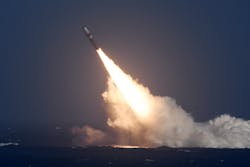Draper to continue research into next-generation guidance system for submarine-launched ballistic missiles
WASHINGTON – U.S. Navy strategic weapons experts are asking the Charles Stark Draper Laboratory Inc. in Cambridge, Mass., to move forward with research towards developing the next-generation guidance system of Trident II submarine-launched ballistic missiles.
Officials of the Navy Strategic Systems Program office in Washington announced a $2.2 billion contract to Draper on 29 Sept. to support strategic guidance, navigation, and control research for follow-on full-scale development of the Trident II's future Mark 7 guidance subsystem.
The Navy's Trident II D5 nuclear missiles are designed for launch from Ohio-class ballistic missile submarines, from the Navy's future Columbia-class submarine, and from British Royal Navy Vanguard-class ballistic-missile submarines.
The contract also is for engineering to maintain the Trident II's Mark 6 guidance subsystem, as well as support construction and integration of the U.S. Navy Columbia-class ballistic submarine, and the United Kingdom Royal Navy Dreadnought ballistic missile submarine.
The future U.S. Columbia-class ballistic missile submarine will enter service in 2031. The future Dreadnought submarine will replace the Royal Navy's fleet of Vanguard-class ballistic missile submarines.
The Trident II nuclear-tipped ballistic missile has a range of more than 7,000 miles and carries four independently targeted 475-kiloton nuclear warheads.
The Trident missile's MK 6 guidance system consists of an electronics assembly with the system's flight computers, and an inertial measurement unit (IMU) with the system's inertial sensors. The electronics assembly interfaces with the submarine's fire-control system and the missile's flight-control electronics assembly. The IMU, meanwhile, senses the motion of missile and provides navigation information to the mission computer.
Trident missiles are aboard 14 Navy Ohio-class submarines and four British Royal Navy Vanguard-class submarines. Each Ohio-class submarine can carry as many as 24 Trident atomic missiles. These vessels together carry about half of all U.S. strategic thermonuclear warheads.
The Draper Lab order is part of a Navy effort begun in 2002 to extend the life of the D5 missiles to the year 2040 by replacing obsolete components with commercial off-the-shelf (COTS) hardware. Upgrades involved the missile reentry systems and guidance systems.
The first flight test of a D5 extended-life subsystem, the MK 6 Mod 1 guidance system, was in early 2012 aboard the ballistic missile submarine USS Tennessee (SSBN 734).
The Trident nuclear missile has a maximum speed of 13,000 miles per hour, and has precision guidance from inertial sensors with star sighting. No GPS-guided Trident D5 missiles have been deployed.
The Trident II missile warhead discharges the energy of 475,000 tons of TNT, and is roughly 30 times the size of the U.S. nuclear bomb dropped on Hiroshima, Japan, in 1945.
On this contract Draper will do the work in Cambridge and Pittsfield, Mass; Washington; Odon, Ind.; Huntsville, Ala.; Cape Canaveral and St. Petersburg, Fla.; and other locations, and should be finished by September/ 2028.
For more information contact Draper Lab online at www.draper.com/business-areas/strategic-systems, or the Navy Strategic Systems Programs Office at www.ssp.navy.mil.
About the Author
John Keller
Editor-in-Chief
John Keller is the Editor-in-Chief, Military & Aerospace Electronics Magazine--provides extensive coverage and analysis of enabling electronics and optoelectronic technologies in military, space and commercial aviation applications. John has been a member of the Military & Aerospace Electronics staff since 1989 and chief editor since 1995.
